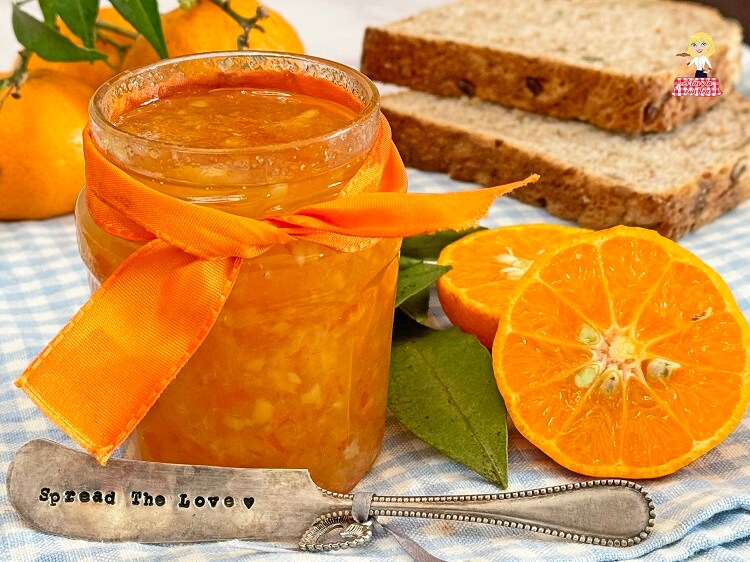A jam that is rarely found in stores but is worth making during the citrus season, which is why I recommend making it at home if, like me, you love this fruit so much.
Tangerine Jam is a preserve with a delicate yet intense flavor and a citrusy aroma, perfect for breakfast to spread on toast with a little butter or on rusks.
It can also be used to fill tartlets, pies, croissants, or cakes, and even to accompany aged cheeses.
I like it because it’s a citrus jam, but a bit sweeter than all the others and has a very delicate taste.
In the recipe I’m sharing today, the tangerines, after being well washed and dried, are blanched in water, cut into wedges, and then deseeded. Then the pulp and peels, once blended, are cooked in a pot with about half their raw weight of sugar.
The result is a thick and delicious Tangerine Jam. The consistency of our jam is rough, for a rustic and bold product also in the mouth.
If you prefer a finer preserve, you can blend it a second time with an immersion blender halfway through cooking, before the jam thickens completely. The tangerines for making the jam should be organic and not chemically treated, sweet, and ripe just right. If you love this citrus fruit, also try the tangerine bread.
The winter period is the right time to make lots of jars to store all year round. Discover how to prepare tangerine jam by following our simple recipe step by step.
For other jam and preserve recipes, also check out

- Difficulty: Very Easy
- Cost: Very Cheap
- Preparation time: 10 Minutes
- Portions: 26.5 oz
- Cooking methods: Stovetop
- Cuisine: Italian
- Energy 83.92 (Kcal)
- Carbohydrates 22.06 (g) of which sugars 20.95 (g)
- Proteins 0.32 (g)
- Fat 0.12 (g) of which saturated 0.02 (g)of which unsaturated 0.05 (g)
- Fibers 0.72 (g)
- Sodium 0.96 (mg)
Indicative values for a portion of 30 g processed in an automated way starting from the nutritional information available on the CREA* and FoodData Central** databases. It is not food and / or nutritional advice.
* CREATES Food and Nutrition Research Center: https://www.crea.gov.it/alimenti-e-nutrizione https://www.alimentinutrizione.it ** U.S. Department of Agriculture, Agricultural Research Service. FoodData Central, 2019. https://fdc.nal.usda.gov
Ingredients
- 2.2 lbs tangerines
- 2 cups sugar
Tools
- Pot
- Blender
- 3 Jars
METHOD
Wash the tangerines under running water and remove the stem if present. In a large pot, heat about 1 quart of water, and when it starts to boil, add the clementines and blanch them for about 5 minutes. Drain the tangerines and place them on a tray with paper towels to dry. Cut the tangerines in half – do not peel them – and remove any seeds with the tip of a knife. Cut the wedges and transfer them to the blender; blend coarsely for a few moments.
Pour the tangerine puree into a saucepan, add the sugar, and cook over low heat, stirring occasionally. Cook the mixture for about 45 minutes: check with a kitchen thermometer that the temperature does not exceed 226°F. Turn off the heat and, leaving the mixture in the pot, blend it with an immersion blender (be careful of splashes as it is hot).
Once the Tangerine Jam is ready, pour it while still hot into sanitized jars, leaving 0.4 inches free from the edge. Close the jars tightly, turn them upside down, and let them cool completely. The tangerine jam is ready! Be sure to check if the vacuum seal was successful once the jars have cooled.

NOTES
You can use the clementine variety if you prefer a slightly sweeter taste; to make your tangerine jam even more fragrant and flavorful, you can flavor it with a cinnamon stick or the seeds of 1 vanilla bean during cooking!
If you really don’t like tangerine peels, remove them, although it would be a shame not to leave them in as it’s not a jam with a bitter aftertaste like orange marmalade can be. The tangerine peel, after 30 minutes of boiling, completely loses its acidity and bitterness but retains a good sweet taste and gives the jam a bit of texture.
STORAGE
If the vacuum seal was successful, Tangerine Jam can be stored in a cool, dry place for about 5 months. Once opened, since it contains no preservatives, I recommend keeping it in the refrigerator and consuming it within a week.
FOR A CORRECT PREPARATION OF HOMEMADE PRESERVES
For a correct preparation of homemade preserves, to avoid health risks, I recommend reading the Ministry of Health guidelines, which provide a list of rules on ingredient handling, pasteurization, and storage.
FAQ (Questions and Answers)
What Goes Well with Tangerine Jam?
Lemon Jam pairs perfectly with fresh and soft cheeses. Pairings with ricotta, burrata, mascarpone, or fresh robiola are particularly recommended.
How to Thicken Tangerine Jam?
To thicken Tangerine Jam, simply cook it by adding apple peels. Then return it to the pot, add the peel from a couple of apples, and let it simmer again for an hour: you’ll see it will gain more consistency.
What Happens if I Don’t Sterilize the Jars for Jam?
Every time you make a preserve at home, you must always sterilize the jars. This procedure is essential to eliminate bacteria and microorganisms present in the food and to avoid the formation of Botulism (Clostridium botulinum), which can spoil the preparations and, more importantly, create many health problems.

